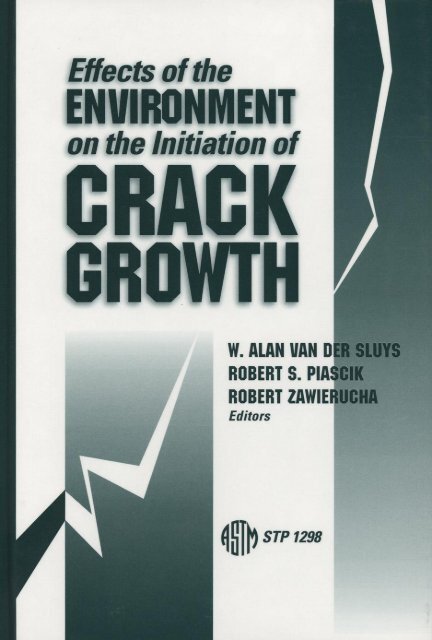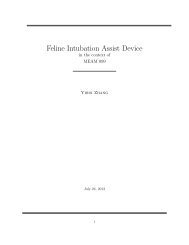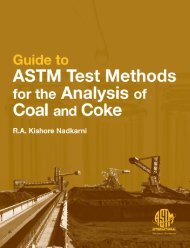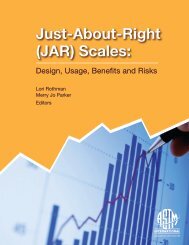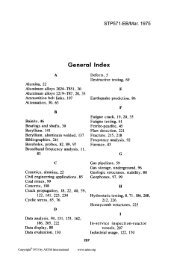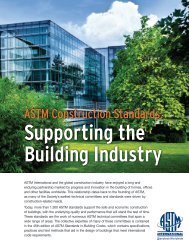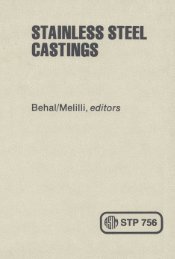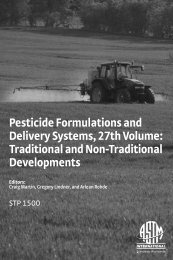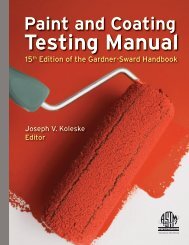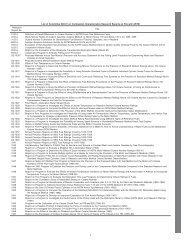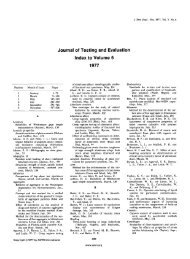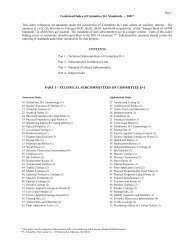Effects of the Environment on the Initiation of Crack Growth - ASTM ...
Effects of the Environment on the Initiation of Crack Growth - ASTM ...
Effects of the Environment on the Initiation of Crack Growth - ASTM ...
You also want an ePaper? Increase the reach of your titles
YUMPU automatically turns print PDFs into web optimized ePapers that Google loves.
STP 1298<br />
<str<strong>on</strong>g>Effects</str<strong>on</strong>g> <str<strong>on</strong>g>of</str<strong>on</strong>g> <str<strong>on</strong>g>the</str<strong>on</strong>g> <str<strong>on</strong>g>Envir<strong>on</strong>ment</str<strong>on</strong>g> <strong>on</strong> <str<strong>on</strong>g>the</str<strong>on</strong>g><br />
Initiati<strong>on</strong> <str<strong>on</strong>g>of</str<strong>on</strong>g> <strong>Crack</strong> <strong>Growth</strong><br />
W. Alan Van Der Sluys, Robert S. Piascik, and Robert<br />
Zawierucha, Editors<br />
<strong>ASTM</strong> Publicati<strong>on</strong> Code Number (PCN):<br />
04-012980-30<br />
<strong>ASTM</strong><br />
100 Barr Harbor Drive<br />
West C<strong>on</strong>shohocken, PA 19428-2959<br />
Printed in <str<strong>on</strong>g>the</str<strong>on</strong>g> U.S.A.
Library <str<strong>on</strong>g>of</str<strong>on</strong>g> C<strong>on</strong>gress Cataloging-in-Publicati<strong>on</strong> Data<br />
<str<strong>on</strong>g>Effects</str<strong>on</strong>g> <str<strong>on</strong>g>of</str<strong>on</strong>g> <str<strong>on</strong>g>the</str<strong>on</strong>g> envir<strong>on</strong>ment <strong>on</strong> <str<strong>on</strong>g>the</str<strong>on</strong>g> initiati<strong>on</strong> <str<strong>on</strong>g>of</str<strong>on</strong>g> crack growth / W. Alan<br />
Van der Sluys, Robert S. Piascik, and Robert Zawierucha, editors.<br />
p. cm. -- (STP : 1298)<br />
Includes bibliographical references ( p. ) and index.<br />
ISBN 0-8031-2408-2<br />
1. Metals--Corrosi<strong>on</strong> fatigue. 2. Metals--<strong>Crack</strong>ing. 3. Metals-<br />
-<str<strong>on</strong>g>Envir<strong>on</strong>ment</str<strong>on</strong>g>al aspects. 4. Nuclear reactors--Materials--<strong>Crack</strong>ing.<br />
I. Van der Sluys, William Alan. II. Piascik, Robert S.<br />
II1. Zawierucha, Robert, 1941-<br />
TA462.E38 1997<br />
620.1 '66--dc21 97-12774<br />
CIP<br />
Copyright 9 1997 AMERICAN SOCIETY FOR TESTING AND MATERIALS, West<br />
C<strong>on</strong>shohocken, PA. All rights reserved. This material may not be reproduced or copied, in<br />
whole or in part, in any printed, mechanical, electr<strong>on</strong>ic, film, or o<str<strong>on</strong>g>the</str<strong>on</strong>g>r distributi<strong>on</strong> and storage<br />
media, without <str<strong>on</strong>g>the</str<strong>on</strong>g> written c<strong>on</strong>sent <str<strong>on</strong>g>of</str<strong>on</strong>g> <str<strong>on</strong>g>the</str<strong>on</strong>g> publisher.<br />
Photocopy Rights<br />
Authorizati<strong>on</strong> to photocopy items for internal, pers<strong>on</strong>al, or educati<strong>on</strong>al classroom<br />
use, or <str<strong>on</strong>g>the</str<strong>on</strong>g> internal, pers<strong>on</strong>al, or educati<strong>on</strong>al classroom use <str<strong>on</strong>g>of</str<strong>on</strong>g> specific clients, is<br />
granted by <str<strong>on</strong>g>the</str<strong>on</strong>g> American Society for Testing and Materials (<strong>ASTM</strong>) provided that <str<strong>on</strong>g>the</str<strong>on</strong>g><br />
appropriate fee is paid to <str<strong>on</strong>g>the</str<strong>on</strong>g> Copyright Clearance Center, 222 Rosewood Drive, Dan-<br />
vers, MA 01923, Tel: 508-750-8400; <strong>on</strong>line: http://www.copyright.com/.<br />
Peer Review Policy<br />
Each paper published in this volume was evaluated by two peer reviewers and at least <strong>on</strong>e<br />
<str<strong>on</strong>g>of</str<strong>on</strong>g> <str<strong>on</strong>g>the</str<strong>on</strong>g> editors. The authors addressed all <str<strong>on</strong>g>of</str<strong>on</strong>g> <str<strong>on</strong>g>the</str<strong>on</strong>g> reviewers' comments to <str<strong>on</strong>g>the</str<strong>on</strong>g> satisfacti<strong>on</strong> <str<strong>on</strong>g>of</str<strong>on</strong>g> both<br />
<str<strong>on</strong>g>the</str<strong>on</strong>g> technical editor(s) and <str<strong>on</strong>g>the</str<strong>on</strong>g> <strong>ASTM</strong> Committee <strong>on</strong> Publicati<strong>on</strong>s.<br />
To make technical informati<strong>on</strong> available as quickly as possible, <str<strong>on</strong>g>the</str<strong>on</strong>g> peer-reviewed papers in<br />
this publicati<strong>on</strong> were prepared "camera-ready" as submitted by <str<strong>on</strong>g>the</str<strong>on</strong>g> authors.<br />
The quality <str<strong>on</strong>g>of</str<strong>on</strong>g> <str<strong>on</strong>g>the</str<strong>on</strong>g> papers in this publicati<strong>on</strong> reflects not <strong>on</strong>ly <str<strong>on</strong>g>the</str<strong>on</strong>g> obvious efforts <str<strong>on</strong>g>of</str<strong>on</strong>g> <str<strong>on</strong>g>the</str<strong>on</strong>g><br />
authors and <str<strong>on</strong>g>the</str<strong>on</strong>g> technical editor(s), but also <str<strong>on</strong>g>the</str<strong>on</strong>g> work <str<strong>on</strong>g>of</str<strong>on</strong>g> <str<strong>on</strong>g>the</str<strong>on</strong>g> peer reviewers. The <strong>ASTM</strong><br />
Committee <strong>on</strong> Publicati<strong>on</strong>s acknowledges with appreciati<strong>on</strong> <str<strong>on</strong>g>the</str<strong>on</strong>g>ir dedicati<strong>on</strong> and c<strong>on</strong>tributi<strong>on</strong><br />
<str<strong>on</strong>g>of</str<strong>on</strong>g> time and effort <strong>on</strong> behalf <str<strong>on</strong>g>of</str<strong>on</strong>g> <strong>ASTM</strong>.<br />
Printed in Ann Arbor<br />
April 1997
Foreword<br />
This publicati<strong>on</strong>, <str<strong>on</strong>g>Effects</str<strong>on</strong>g> <str<strong>on</strong>g>of</str<strong>on</strong>g> <str<strong>on</strong>g>the</str<strong>on</strong>g> <str<strong>on</strong>g>Envir<strong>on</strong>ment</str<strong>on</strong>g> <strong>on</strong> <str<strong>on</strong>g>the</str<strong>on</strong>g> Initiati<strong>on</strong> <str<strong>on</strong>g>of</str<strong>on</strong>g> <strong>Crack</strong> <strong>Growth</strong>, c<strong>on</strong>tains<br />
papers presented at <str<strong>on</strong>g>the</str<strong>on</strong>g> symposium <str<strong>on</strong>g>of</str<strong>on</strong>g> <str<strong>on</strong>g>the</str<strong>on</strong>g> same name held in Orlando, Florida, <strong>on</strong> 20-21<br />
May 1996. The symposium was sp<strong>on</strong>sored by <strong>ASTM</strong> Committee E-08 <strong>on</strong> Fatigue and<br />
Fracture, G01 <strong>on</strong> Corrosi<strong>on</strong> <str<strong>on</strong>g>of</str<strong>on</strong>g> Metals, and Subcommittees E08.06 <strong>on</strong> <strong>Crack</strong> <strong>Growth</strong><br />
Behavior and G01.06 <strong>on</strong> Stress Corrosi<strong>on</strong> <strong>Crack</strong>ing and Corrosi<strong>on</strong> Fatigue. The sympo-<br />
sium was chaired by W. Alan Van Der Sluys, Babcock & Wilcox; Robert S. Piascik, NASA<br />
Langley Research Center, and Robert Zawierucha, Praxair, Inc. They also served as edi-<br />
tors <str<strong>on</strong>g>of</str<strong>on</strong>g> this publicati<strong>on</strong>.
C<strong>on</strong>tents<br />
Overview vii<br />
STRESS CORROSION CRACKING INITIATION<br />
The Role <str<strong>on</strong>g>of</str<strong>on</strong>g> Stress-Assisted Localized Corrosi<strong>on</strong> in <str<strong>on</strong>g>the</str<strong>on</strong>g> Development <str<strong>on</strong>g>of</str<strong>on</strong>g> Short<br />
Fatigue <strong>Crack</strong>S~ROBERT AKID<br />
Pitting Corrosi<strong>on</strong> and Fatigue <strong>Crack</strong> Nucleati<strong>on</strong>~GIM s. CHEN, CHI-MIN LIAO,<br />
KUANG-CHUNG WAN, MING GAO, AND ROBERT P. WEI<br />
Initiati<strong>on</strong> <str<strong>on</strong>g>of</str<strong>on</strong>g> Stress-Corrosi<strong>on</strong> <strong>Crack</strong>ing <strong>on</strong> Gas Transmissi<strong>on</strong> Piping~<br />
BRIAN N. LEIS AND JEFFERY A. COLWELL<br />
CRACK INITIATION IN AGING AIRCRAFT<br />
On <str<strong>on</strong>g>the</str<strong>on</strong>g> Requirement for a Sharp Notch or Precrack to Cause<br />
<str<strong>on</strong>g>Envir<strong>on</strong>ment</str<strong>on</strong>g>ally Assisted <strong>Crack</strong> Initiati<strong>on</strong> <str<strong>on</strong>g>of</str<strong>on</strong>g>/]-Titanium Alloys<br />
Exposed to Aqueous Chloride <str<strong>on</strong>g>Envir<strong>on</strong>ment</str<strong>on</strong>g>smDAViD G. KOLMAN AND<br />
JOHN R. SCULLY<br />
Corrosi<strong>on</strong>-Fatigue <strong>Crack</strong> Nucleati<strong>on</strong> in Alclad 2024-T3 Commercial AircraR<br />
Skin--CHARLES G. SCHMIDT, JAMES E. CROCKER, JACQUES H. GIOVANOLA,<br />
CHRISTINE H. KANAZAWA, DONALD A. SHOCKEY, AND THOMAS H. FLOURNOY<br />
Effect <str<strong>on</strong>g>of</str<strong>on</strong>g> Prior Corrosi<strong>on</strong> <strong>on</strong> <str<strong>on</strong>g>the</str<strong>on</strong>g> S/N Fatigue Performance <str<strong>on</strong>g>of</str<strong>on</strong>g> Aluminum<br />
Sheet Alloys 2024-T3 and 2524-T3mGARY a. BRAY, ROBERT J. 8UCCI,<br />
EDWARD L. COLVIN, AND MICHAEL KULAK<br />
STRESS CORROSION CRACK INITIATION IN NUCLEAR ENVIRONMENTS<br />
Influence <str<strong>on</strong>g>of</str<strong>on</strong>g> a Mixed Nitrate Soluti<strong>on</strong> <strong>on</strong> <str<strong>on</strong>g>the</str<strong>on</strong>g> Initiati<strong>on</strong> and Early <strong>Growth</strong> <str<strong>on</strong>g>of</str<strong>on</strong>g><br />
Stress Corrosi<strong>on</strong> <strong>Crack</strong>s in a Low Alloy SteeI--REDVERS N. PARKINS<br />
AND MAHVASH MIRZAI<br />
<str<strong>on</strong>g>Envir<strong>on</strong>ment</str<strong>on</strong>g>ally Assisted <strong>Crack</strong>ing <str<strong>on</strong>g>of</str<strong>on</strong>g> 3.5NiCrMov Low Alloy Steel Under<br />
Cyclic Straining--YOSHiYUKI KONDO, MASARU BODAI, MAO TAKEI,<br />
YUJI SUGITA, AND HIRONOBU INAGAKI<br />
<strong>Crack</strong> Initiati<strong>on</strong> in Low Alloy Steel in High Temperature Watern<br />
HARVEY D. SOLOMON, RON E. DELAIR, AND ANDY D. UNRUH<br />
A Process Model for <str<strong>on</strong>g>the</str<strong>on</strong>g> Initiati<strong>on</strong> <str<strong>on</strong>g>of</str<strong>on</strong>g> Stress-Corrosi<strong>on</strong> <strong>Crack</strong> <strong>Growth</strong> in<br />
BWR Plant MaterialS--MASATSUNE AKASHI AND GUEN NAKAYAMA 150<br />
18<br />
34<br />
61<br />
74<br />
89<br />
107<br />
120<br />
135
MODELING<br />
Strain Energy Density--Distance Criteri<strong>on</strong> for <str<strong>on</strong>g>the</str<strong>on</strong>g> Initiati<strong>on</strong> <str<strong>on</strong>g>of</str<strong>on</strong>g> Stress<br />
Corrosi<strong>on</strong> <strong>Crack</strong>ing <str<strong>on</strong>g>of</str<strong>on</strong>g> Alloy X-750mMERYL M. HALL, JR. AND<br />
DOUGLAS M. SYMONS<br />
Molecular Modeling <str<strong>on</strong>g>of</str<strong>on</strong>g> Corrosive <str<strong>on</strong>g>Envir<strong>on</strong>ment</str<strong>on</strong>g>s in <strong>Crack</strong>s--OTAKAR JONAS<br />
CRACK INITIATION IN CORROSION FATIGUE--I<br />
Interactive Effect <str<strong>on</strong>g>of</str<strong>on</strong>g> Dynamic Strain Ageing with High Temperature Water<br />
<strong>on</strong> <str<strong>on</strong>g>the</str<strong>on</strong>g> <strong>Crack</strong> Initiati<strong>on</strong> Behaviour <str<strong>on</strong>g>of</str<strong>on</strong>g> Reactor Pressure Vessel Steels--<br />
JOHN D. ATKINSON, ZHI-JUN ZHAO, AND JIAN YU<br />
<str<strong>on</strong>g>Effects</str<strong>on</strong>g> <str<strong>on</strong>g>of</str<strong>on</strong>g> Strain Rate Change <strong>on</strong> Fatigue Life <str<strong>on</strong>g>of</str<strong>on</strong>g> Carb<strong>on</strong> Steel in High-<br />
Temperature WatermMAKOTO HIGUCHI, KUNmIRO nDA, AND<br />
YASUHIDE ASADA<br />
<str<strong>on</strong>g>Effects</str<strong>on</strong>g> <str<strong>on</strong>g>of</str<strong>on</strong>g> Temperature and Dissolved Oxygen C<strong>on</strong>tents <strong>on</strong> Fatigue Lives <str<strong>on</strong>g>of</str<strong>on</strong>g><br />
Carb<strong>on</strong> and Low Alloy Steels in LWR Water <str<strong>on</strong>g>Envir<strong>on</strong>ment</str<strong>on</strong>g>s--<br />
GENROKU NAKAO, MAKOTO HIGUCHI, HIROSHI KANASAKI, KUNIHIRO IIDA,<br />
AND YASUHIDE ASADA<br />
CRACK INITIATION IN CORROSION FATIGUE--II<br />
Evaluati<strong>on</strong> <str<strong>on</strong>g>of</str<strong>on</strong>g> <str<strong>on</strong>g>Effects</str<strong>on</strong>g> <str<strong>on</strong>g>of</str<strong>on</strong>g> LWR Coolant <str<strong>on</strong>g>Envir<strong>on</strong>ment</str<strong>on</strong>g>s <strong>on</strong> Fatigue Life <str<strong>on</strong>g>of</str<strong>on</strong>g><br />
Carb<strong>on</strong> and Low-Alloy Steels--OMESH K. CHOPRA AND WILLIAM J, SHACK<br />
Corrosi<strong>on</strong> Fatigue Behavior and Life Predicti<strong>on</strong> Method Under Changing<br />
Temperature C<strong>on</strong>diti<strong>on</strong>--H1ROSHl KANASAKI, AKIHIKO HIRANO,<br />
KUNIHIRO IIDA, AND YASUHIDE ASADA<br />
Advances in <str<strong>on</strong>g>Envir<strong>on</strong>ment</str<strong>on</strong>g>al Fatigue Evaluati<strong>on</strong> for Light Water Reactor<br />
Comp<strong>on</strong>ents--KAZUO KISHIDA, TOSHIMITSU UMAKOSHI, AND<br />
Indexes<br />
YASUHIDE ASADA<br />
167<br />
182<br />
199<br />
216<br />
232<br />
247<br />
267<br />
282<br />
299
Overview<br />
The initiati<strong>on</strong> stage <str<strong>on</strong>g>of</str<strong>on</strong>g> envir<strong>on</strong>mentally assisted cracking can have a pr<str<strong>on</strong>g>of</str<strong>on</strong>g>ound effect <strong>on</strong><br />
<str<strong>on</strong>g>the</str<strong>on</strong>g> life <str<strong>on</strong>g>of</str<strong>on</strong>g> a comp<strong>on</strong>ent. Little is known about <str<strong>on</strong>g>the</str<strong>on</strong>g> damage mechanisms that occur during <str<strong>on</strong>g>the</str<strong>on</strong>g><br />
important early stages <str<strong>on</strong>g>of</str<strong>on</strong>g> crack formati<strong>on</strong>, e.g., nucleati<strong>on</strong> and small crack growth, com-<br />
pared to <str<strong>on</strong>g>the</str<strong>on</strong>g> crack propagati<strong>on</strong> regime. This Special Technical Publicati<strong>on</strong> reviews current<br />
understanding <strong>on</strong> <str<strong>on</strong>g>the</str<strong>on</strong>g> effects <str<strong>on</strong>g>of</str<strong>on</strong>g> <str<strong>on</strong>g>the</str<strong>on</strong>g> envir<strong>on</strong>ment <strong>on</strong> <str<strong>on</strong>g>the</str<strong>on</strong>g> initiati<strong>on</strong> <str<strong>on</strong>g>of</str<strong>on</strong>g> crack growth relating to<br />
specific areas, including: (1) mechanistic modeling, (2) life predicti<strong>on</strong>, (3) nuclear industry<br />
envir<strong>on</strong>mental cracking, and (4) recent aging aircraft durability issues. The following is a<br />
brief overview <str<strong>on</strong>g>of</str<strong>on</strong>g> <str<strong>on</strong>g>the</str<strong>on</strong>g> symposium papers included in this topical volume.<br />
Sessi<strong>on</strong> h Stress Corrosi<strong>on</strong> <strong>Crack</strong>ing Initiati<strong>on</strong><br />
Akid discussed <str<strong>on</strong>g>the</str<strong>on</strong>g> role <str<strong>on</strong>g>of</str<strong>on</strong>g> stress-assisted localized corrosi<strong>on</strong> <strong>on</strong> <str<strong>on</strong>g>the</str<strong>on</strong>g> development <str<strong>on</strong>g>of</str<strong>on</strong>g> short<br />
fatigue cracks. Corrosi<strong>on</strong> experiments were c<strong>on</strong>ducted under cyclic and static stress, using<br />
low and high strength steels and stainless steels in chloride envir<strong>on</strong>ments. Surface film<br />
breakdown, pit development and growth, pit/crack transiti<strong>on</strong>, and envir<strong>on</strong>ment-assisted<br />
Stage I and Stage II crack growth were m<strong>on</strong>itored. Each process is c<strong>on</strong>sidered to be <str<strong>on</strong>g>of</str<strong>on</strong>g><br />
primary importance during <str<strong>on</strong>g>the</str<strong>on</strong>g> early stages <str<strong>on</strong>g>of</str<strong>on</strong>g> stress corrosi<strong>on</strong> and corrosi<strong>on</strong> fatigue crack-<br />
ing.<br />
Chen, Liao, Wan, Gao, and Wei assess two proposed pit to crack transiti<strong>on</strong> criteria: (1)<br />
<str<strong>on</strong>g>the</str<strong>on</strong>g> stress intensity factor for an equivalent crack, equal, or exceeded <str<strong>on</strong>g>the</str<strong>on</strong>g> threshold stress<br />
intensity factor for corrosi<strong>on</strong> fatigue crack growth (CFCG), and (2) <str<strong>on</strong>g>the</str<strong>on</strong>g> time-based CFCG<br />
rate exceeded <str<strong>on</strong>g>the</str<strong>on</strong>g> pit growth. Validati<strong>on</strong> <str<strong>on</strong>g>of</str<strong>on</strong>g> a proposed pitting corrosi<strong>on</strong>/fatigue crack<br />
nucleati<strong>on</strong> criteri<strong>on</strong> is presented and discussed in terms <str<strong>on</strong>g>of</str<strong>on</strong>g> open hole alloy 2024-T3 experi-<br />
ments c<strong>on</strong>ducted in 0.5M NaC1 soluti<strong>on</strong>.<br />
Leis and Colwell studied <str<strong>on</strong>g>the</str<strong>on</strong>g> processes leading to <str<strong>on</strong>g>the</str<strong>on</strong>g> formati<strong>on</strong> <str<strong>on</strong>g>of</str<strong>on</strong>g> crack-like features as<br />
well as early crack growth <str<strong>on</strong>g>of</str<strong>on</strong>g> stress-corrosi<strong>on</strong> cracking <strong>on</strong> <str<strong>on</strong>g>the</str<strong>on</strong>g> exterior <str<strong>on</strong>g>of</str<strong>on</strong>g> gas transmissi<strong>on</strong><br />
piping. Observati<strong>on</strong>s show that cracks with dense spacing tend towards dormancy, whereas<br />
<str<strong>on</strong>g>the</str<strong>on</strong>g> sparsely spaced cracks c<strong>on</strong>tinue to grow. Fracture mechanics based analysis is used to<br />
rati<strong>on</strong>alize <str<strong>on</strong>g>the</str<strong>on</strong>g> crack pattern observati<strong>on</strong>s.<br />
Sessi<strong>on</strong> II: <strong>Crack</strong> Initiati<strong>on</strong> in Aging Aircraft<br />
Kolman and Scully examined <str<strong>on</strong>g>the</str<strong>on</strong>g> effects <str<strong>on</strong>g>of</str<strong>on</strong>g> a sharp notch or crack tip <strong>on</strong> cati<strong>on</strong> accumula-<br />
ti<strong>on</strong>-hydrolysis-acidificati<strong>on</strong>, potential drop in soluti<strong>on</strong> and resulting hydrogen produc-<br />
ti<strong>on</strong>, and localizati<strong>on</strong> <strong>on</strong> dynamic strain in titanium alloys exposed to 0.6 M NaCI. It was<br />
shown that <str<strong>on</strong>g>the</str<strong>on</strong>g> drop in potential down a sharp crack is severe enough to enable hydrogen<br />
producti<strong>on</strong>, even when <str<strong>on</strong>g>the</str<strong>on</strong>g> applied potential is more positive than <str<strong>on</strong>g>the</str<strong>on</strong>g> reversible potential for<br />
hydrogen producti<strong>on</strong>. The effects <str<strong>on</strong>g>of</str<strong>on</strong>g> a sharp notch <strong>on</strong> <str<strong>on</strong>g>the</str<strong>on</strong>g> interplay <str<strong>on</strong>g>of</str<strong>on</strong>g> mechanics, film<br />
rupture, and hydrogen uptake are also examined.<br />
Schmidt, Crocker, Giovanola, Kanazawa, Shockey, and Flournoy investigated <str<strong>on</strong>g>the</str<strong>on</strong>g> pro-<br />
cesses that influence <str<strong>on</strong>g>the</str<strong>on</strong>g> transiti<strong>on</strong> from salt water corrosi<strong>on</strong> pit development to fatigue<br />
crack formati<strong>on</strong> in Alcad 2024-T3. Results suggest that <str<strong>on</strong>g>the</str<strong>on</strong>g> nucleati<strong>on</strong> <str<strong>on</strong>g>of</str<strong>on</strong>g> corrosi<strong>on</strong> fatigue<br />
cracks involves two competing mechanisms: hydrogen effects in <str<strong>on</strong>g>the</str<strong>on</strong>g> cladding and electro-<br />
chemical dissoluti<strong>on</strong> at c<strong>on</strong>stituent particles in alloy 2024. <strong>Crack</strong>s do not necessarily nucle-<br />
vii
viii EFFECTS OF THE ENVIRONMENT ON THE INITIATION OF CRACK GROWTH<br />
ate at <str<strong>on</strong>g>the</str<strong>on</strong>g> largest corrosi<strong>on</strong> pit, suggesting that a c<strong>on</strong>tributing factor to crack nucleati<strong>on</strong> from<br />
a pit may be <str<strong>on</strong>g>the</str<strong>on</strong>g> creati<strong>on</strong> <str<strong>on</strong>g>of</str<strong>on</strong>g> a local regi<strong>on</strong> <str<strong>on</strong>g>of</str<strong>on</strong>g> weakness.<br />
Bray, Bucci, Colvin, and Kulak evaluate <str<strong>on</strong>g>the</str<strong>on</strong>g> effect <str<strong>on</strong>g>of</str<strong>on</strong>g> prior corrosi<strong>on</strong> <strong>on</strong> <str<strong>on</strong>g>the</str<strong>on</strong>g> S/N fatigue<br />
performance <str<strong>on</strong>g>of</str<strong>on</strong>g> 1.60 and 3.17-mm-thick aluminum sheet alloys 2524-T3 and 2024-T3. The<br />
fatigue strength <str<strong>on</strong>g>of</str<strong>on</strong>g> alloy 2524 was approximately 10% greater and <str<strong>on</strong>g>the</str<strong>on</strong>g> lifetime to failure, 30<br />
to 45% l<strong>on</strong>ger than alloy 2024. Two main factors are believed to have c<strong>on</strong>tributed to <str<strong>on</strong>g>the</str<strong>on</strong>g><br />
better performance <str<strong>on</strong>g>of</str<strong>on</strong>g> 2524: less damaging c<strong>on</strong>figurati<strong>on</strong> <str<strong>on</strong>g>of</str<strong>on</strong>g> corrosi<strong>on</strong> pits and its better<br />
fatigue crack growth resistance.<br />
Sessi<strong>on</strong> III: Stress Corrosi<strong>on</strong> <strong>Crack</strong> Initiati<strong>on</strong> in Nuclear <str<strong>on</strong>g>Envir<strong>on</strong>ment</str<strong>on</strong>g>s<br />
Parkins and Mirzai provide a database that will allow predicti<strong>on</strong> <str<strong>on</strong>g>of</str<strong>on</strong>g> stress corrosi<strong>on</strong><br />
cracking failures in nuclear reactor comp<strong>on</strong>ents exposed to <str<strong>on</strong>g>the</str<strong>on</strong>g> radiolysis <str<strong>on</strong>g>of</str<strong>on</strong>g> moist air which<br />
produce nitric acid envir<strong>on</strong>ments. C<strong>on</strong>stant strain stress corrosi<strong>on</strong> tests, at 50 or 100% yield<br />
stress, were c<strong>on</strong>ducted <strong>on</strong> welded nickel based steel samples exposed to a mixed nitrate<br />
soluti<strong>on</strong> for various times. Selective attack at relatively short exposure times was observed<br />
where grain boundaries intersected <str<strong>on</strong>g>the</str<strong>on</strong>g> specimen surfaces.<br />
K<strong>on</strong>do, Bodai, Takei, Sugita, and Inagaki studied envir<strong>on</strong>mentally assisted cracking <str<strong>on</strong>g>of</str<strong>on</strong>g><br />
3.5NiCrMoV low alloy steel under cyclic straining in water at 60~ Test results showed<br />
that higher strain range, lower strain rate, l<strong>on</strong>ger strain hold times, and higher electric<br />
c<strong>on</strong>ductivity caused increased charge transfer, which resulted in shorter crack initiati<strong>on</strong> life.<br />
A predicti<strong>on</strong> model tbr crack initiati<strong>on</strong> life was proposed based <strong>on</strong> observed charge transfer.<br />
Soloman, DeLair, and Unruh investigated <str<strong>on</strong>g>the</str<strong>on</strong>g> fatigue crack initiati<strong>on</strong> <str<strong>on</strong>g>of</str<strong>on</strong>g> WB36, a German<br />
low alloy steel (LAS), tested in high-temperature high-purity water. The tests were per-<br />
formed at 177~ in water c<strong>on</strong>taining 8 ppm 02. H2504 additi<strong>on</strong>s were also used in some<br />
tests to raise <str<strong>on</strong>g>the</str<strong>on</strong>g> c<strong>on</strong>ductivity <str<strong>on</strong>g>of</str<strong>on</strong>g> <str<strong>on</strong>g>the</str<strong>on</strong>g> water from 0.06 to 0.4-0.5 ~xS/cm. The crack initiati<strong>on</strong><br />
and growth data are correlated with water chemistry.<br />
Akashi and Nakayama investigated <str<strong>on</strong>g>the</str<strong>on</strong>g> initiati<strong>on</strong> <str<strong>on</strong>g>of</str<strong>on</strong>g> stress corrosi<strong>on</strong> cracking in boiling<br />
water reactor materials. They suggest that stress corrosi<strong>on</strong> cracking can be divided into six<br />
(three deterministic and three stochastic) separate processes. The paper examines <str<strong>on</strong>g>the</str<strong>on</strong>g> influ-<br />
ence <str<strong>on</strong>g>of</str<strong>on</strong>g> three stochastic processes: (1) nucleati<strong>on</strong> <str<strong>on</strong>g>of</str<strong>on</strong>g> corrosi<strong>on</strong> pits, (2) initiati<strong>on</strong> <str<strong>on</strong>g>of</str<strong>on</strong>g> micro<br />
cracks, and (3) <str<strong>on</strong>g>the</str<strong>on</strong>g> coalescence <str<strong>on</strong>g>of</str<strong>on</strong>g> microcracks, <strong>on</strong> <str<strong>on</strong>g>the</str<strong>on</strong>g> stress corrosi<strong>on</strong> cracking initiati<strong>on</strong><br />
process.<br />
Sessi<strong>on</strong> IV: Modeling<br />
Hall and Sym<strong>on</strong>s showed that <str<strong>on</strong>g>the</str<strong>on</strong>g> initiati<strong>on</strong> <str<strong>on</strong>g>of</str<strong>on</strong>g> stress corrosi<strong>on</strong> cracking in alloy X-750<br />
exposed to high-temperature-deaerated water occur at a variable distance from <str<strong>on</strong>g>the</str<strong>on</strong>g> notch or<br />
crack tip. The initiati<strong>on</strong> site varies from very near <str<strong>on</strong>g>the</str<strong>on</strong>g> crack tip, for loaded sharp cracks, to a<br />
site that is <strong>on</strong>e grain diameter from <str<strong>on</strong>g>the</str<strong>on</strong>g> notch, for lower loaded, blunt notches. The existence<br />
<str<strong>on</strong>g>of</str<strong>on</strong>g> hydrogen gradients, which are due to strain-induced hydrogen trapping in <str<strong>on</strong>g>the</str<strong>on</strong>g> strain fields<br />
<str<strong>on</strong>g>of</str<strong>on</strong>g> <str<strong>on</strong>g>the</str<strong>on</strong>g> notch and crack tips <str<strong>on</strong>g>of</str<strong>on</strong>g> <str<strong>on</strong>g>the</str<strong>on</strong>g> SCC test specimens, is argued to be resp<strong>on</strong>sible for<br />
variati<strong>on</strong> in <str<strong>on</strong>g>the</str<strong>on</strong>g> crack initiati<strong>on</strong> site.<br />
O. J<strong>on</strong>as presented a corrosi<strong>on</strong> model for ir<strong>on</strong>-based alloys. Interacti<strong>on</strong>s <str<strong>on</strong>g>of</str<strong>on</strong>g> aqueous<br />
envir<strong>on</strong>ments in cracks are expressed as relative b<strong>on</strong>ding energies for individual molecules<br />
and o<str<strong>on</strong>g>the</str<strong>on</strong>g>r parameters. The results indicate relative aggressiveness <str<strong>on</strong>g>of</str<strong>on</strong>g> envir<strong>on</strong>ments, types <str<strong>on</strong>g>of</str<strong>on</strong>g><br />
chemical/corrosi<strong>on</strong> reacti<strong>on</strong>s, and <str<strong>on</strong>g>the</str<strong>on</strong>g> rate <str<strong>on</strong>g>of</str<strong>on</strong>g> mass transport to <str<strong>on</strong>g>the</str<strong>on</strong>g> crack-tip.
Sessi<strong>on</strong> V and Vh <strong>Crack</strong> Initiati<strong>on</strong> in Corrosi<strong>on</strong> Fatigue<br />
OVERVIEW ix<br />
Atkins<strong>on</strong>, Zhao, and Yu investigated <str<strong>on</strong>g>the</str<strong>on</strong>g> effect <str<strong>on</strong>g>of</str<strong>on</strong>g> dynamic strain aging (DSA) <strong>on</strong> stress<br />
corrosi<strong>on</strong> cracking <str<strong>on</strong>g>of</str<strong>on</strong>g> reactor pressure vessel steels exposed to 250~ water. Results support<br />
<str<strong>on</strong>g>the</str<strong>on</strong>g> coincidence <str<strong>on</strong>g>of</str<strong>on</strong>g> temperature and strain rate between <str<strong>on</strong>g>the</str<strong>on</strong>g> DSA hardening and <str<strong>on</strong>g>the</str<strong>on</strong>g> suscepti-<br />
bility to envir<strong>on</strong>ment-assisted cracking <str<strong>on</strong>g>of</str<strong>on</strong>g> reactor pressure steels. The mechanistic role <str<strong>on</strong>g>of</str<strong>on</strong>g><br />
DSA and its interpretati<strong>on</strong> with o<str<strong>on</strong>g>the</str<strong>on</strong>g>r influential variables in <str<strong>on</strong>g>the</str<strong>on</strong>g> enhancement <str<strong>on</strong>g>of</str<strong>on</strong>g> stress<br />
corrosi<strong>on</strong> cracking are discussed.<br />
Higuchi, Iida, and Asada studied <str<strong>on</strong>g>the</str<strong>on</strong>g> effect <str<strong>on</strong>g>of</str<strong>on</strong>g> strain rate <strong>on</strong> <str<strong>on</strong>g>the</str<strong>on</strong>g> fatigue life <str<strong>on</strong>g>of</str<strong>on</strong>g> carb<strong>on</strong> steel<br />
exposed to high-temperature water c<strong>on</strong>taining dissolved oxygen. A series <str<strong>on</strong>g>of</str<strong>on</strong>g> strain-c<strong>on</strong>-<br />
trolled fatigue tests were c<strong>on</strong>ducted with strain rate changed stepwise or c<strong>on</strong>tinuously. A<br />
method using <str<strong>on</strong>g>the</str<strong>on</strong>g> product <str<strong>on</strong>g>of</str<strong>on</strong>g> <str<strong>on</strong>g>the</str<strong>on</strong>g> envir<strong>on</strong>mental effect and <str<strong>on</strong>g>the</str<strong>on</strong>g> strain increment within a unit<br />
time interval in a transient period is integrated from <str<strong>on</strong>g>the</str<strong>on</strong>g> minimum strain to <str<strong>on</strong>g>the</str<strong>on</strong>g> maximum.<br />
This modified strain rate approach method is discussed in detail.<br />
Nakao, Higuchi, Kanasaki, Iida, and Asada investigated <str<strong>on</strong>g>the</str<strong>on</strong>g> fatigue design <str<strong>on</strong>g>of</str<strong>on</strong>g> pressure<br />
vessel comp<strong>on</strong>ents. They show that decreased fatigue life <str<strong>on</strong>g>of</str<strong>on</strong>g> STS410 carb<strong>on</strong> in simulated<br />
boiling water reactor water is dependent <strong>on</strong> temperature and dissolved oxygen. An envir<strong>on</strong>-<br />
ment parameter ratio, Rp, is proposed for <str<strong>on</strong>g>the</str<strong>on</strong>g> estimate <str<strong>on</strong>g>of</str<strong>on</strong>g> <str<strong>on</strong>g>the</str<strong>on</strong>g> fatigue life at a certain<br />
temperature and dissolved oxygen c<strong>on</strong>tent.<br />
Chopra and Shack summarized <str<strong>on</strong>g>the</str<strong>on</strong>g> available data <strong>on</strong> <str<strong>on</strong>g>the</str<strong>on</strong>g> effects <str<strong>on</strong>g>of</str<strong>on</strong>g> various material and<br />
loading variables such as steel type, dissolved oxygen level, strain range, strain rate, and<br />
sulfur c<strong>on</strong>tent <strong>on</strong> <str<strong>on</strong>g>the</str<strong>on</strong>g> fatigue life <str<strong>on</strong>g>of</str<strong>on</strong>g> carb<strong>on</strong> steel and low-alloy steels. The data have been<br />
analyzed to define <str<strong>on</strong>g>the</str<strong>on</strong>g> threshold values <str<strong>on</strong>g>of</str<strong>on</strong>g> <str<strong>on</strong>g>the</str<strong>on</strong>g> five critical parameters. Methods for esti-<br />
mating fatigue lives under actual loading histories were discussed.<br />
Kanasaki, Hirano, Iida, and Asada performed strain c<strong>on</strong>trolled low cycle fatigue tests <str<strong>on</strong>g>of</str<strong>on</strong>g> a<br />
carb<strong>on</strong> steel in oxygenated high-temperature water. The corrosi<strong>on</strong> fatigue life predicti<strong>on</strong><br />
method was proposed for changing temperature c<strong>on</strong>diti<strong>on</strong>s. The method is based <strong>on</strong> <str<strong>on</strong>g>the</str<strong>on</strong>g><br />
assumpti<strong>on</strong> that <str<strong>on</strong>g>the</str<strong>on</strong>g> fatigue damage increased linearly with <str<strong>on</strong>g>the</str<strong>on</strong>g> fatigue cycle strain incre-<br />
ment. The fatigue life predicted by this method was in good agreement with <str<strong>on</strong>g>the</str<strong>on</strong>g> test results.<br />
Kishida, Umakoshi, and Asada proposed a method for evaluating <str<strong>on</strong>g>the</str<strong>on</strong>g> envir<strong>on</strong>mental<br />
fatigue lives tbr <str<strong>on</strong>g>the</str<strong>on</strong>g> Class I reactor pressure. A revised simplified method is developed Ibr<br />
<str<strong>on</strong>g>the</str<strong>on</strong>g> determinati<strong>on</strong> <str<strong>on</strong>g>of</str<strong>on</strong>g> a fatigue usage factor for a comp<strong>on</strong>ent in which loading transients<br />
include variati<strong>on</strong> <str<strong>on</strong>g>of</str<strong>on</strong>g> temperature, strain rate, and oxygen c<strong>on</strong>tent in additi<strong>on</strong> to <str<strong>on</strong>g>the</str<strong>on</strong>g> strain<br />
range. A number <str<strong>on</strong>g>of</str<strong>on</strong>g> examples are presented in which an envir<strong>on</strong>mental effect correcti<strong>on</strong><br />
factor is determined for comp<strong>on</strong>ents in a nuclear pressure boundary.<br />
W. Alan Van Der Sluys<br />
Babcock & Wilcox;<br />
Alliance Ohio; symposium chairman and<br />
STP editor<br />
Robert S. Piascik<br />
NASA Langley Research Center;<br />
P.O. Box MS 188E,<br />
Hampt<strong>on</strong>, Virginia; symposium co-<br />
chairman and STP editor<br />
Robert Zawierucha<br />
Praxair, Inc., T<strong>on</strong>awanda, New York;<br />
symposium co-chairman and STP editor
ISBN 0-8031-2408-2


